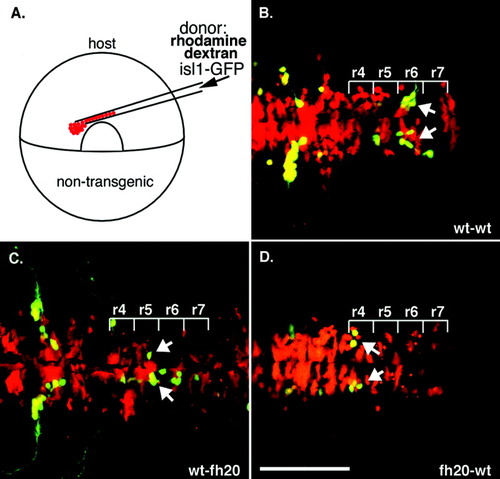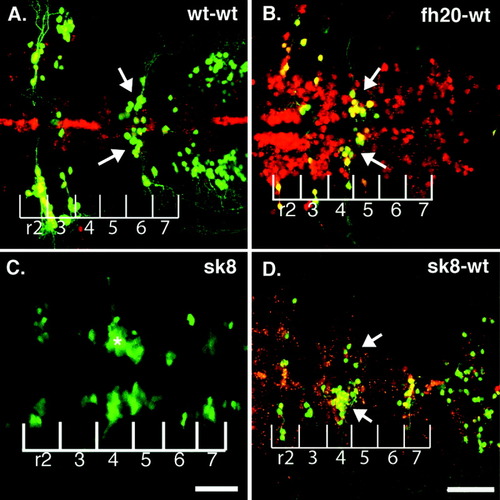- Title
-
Zebrafish foggy/spt5 is required for migration of facial branchiomotor neurons but not for their survival
- Authors
- Cooper, K.L., Armstrong, J., and Moens, C.B.
- Source
- Full text @ Dev. Dyn.
|
A: fh20-/- mutant embryos exhibit multiple defects, including failure of facial branchiomotor neuron migration. Anterior is to the left in all panels. B: The morphological phenotype of fh20-/- embryos includes developmental delay and failure of tail elongation, absence of pigment formation, failure of the ventral retina to close, heart tube hypotrophy accompanied by pericardial edema, and degeneration of somites. C,D: The mutation is lethal at approximately 4 days postfertilization (dpf). Terminal deoxynucleotidyl transferase-mediated deoxyuridinetriphosphate nick end-labeling (TUNEL) labeling indicates that apoptotic cell death is increased in fh20-/- (D) compared with wild-type (C). E,F: Facial branchiomotor neurons (asterisks) fail to migrate posteriorly from r4 in isl1-GFP transgenic fh20-/- embryos (F) compared with wild-type (E). G: Full-length wild-type spt5 mRNA injected into fh20-/- embryos rescues facial branchiomotor neuron migration. H: Polymerase chain reaction genotypes for an absolutely linked microsatellite marker (30020R9) in (1) homozygous wild-type, (2) fh20+/-, (3) fh20-/-, and (4) the rescued fh20-/- embryo shown in G. I,J: In situ hybridization for ngn1 expression indicates a decrease in intensity that correlates with the fh20 mutation: wild-type (I) and fh20-/- (J). K,L: Facial branchiomotor neurons, identified by islet1 in situ hybridization, migrate normally in the m806 point mutant of foggy/spt5 that abolishes the negative effect on transcript elongation. Scale bars = 900 μm in A,B, 100 μm in C-L. EXPRESSION / LABELING:
|
|
foggy/spt5 is required cell-autonomously for facial branchiomotor neuron migration. A: Genetic mosaics were generated by transplanting cells from rhodamine dextran-labeled isl1-green fluorescent protein (GFP) transgenic donor cells to unlabeled hosts at gastrula stage (6 hours postfertilization [hpf]), and confocal images were collected at 36 hpf. Donor-derived cells are red, and donor derived motor neurons, which express GFP, are yellow. B: Wild-type facial motor neurons (arrow) migrate posteriorly in a wild-type host; n = 14 of 14. C: Wild-type facial motor neurons (arrows) also migrate posteriorly from rhombomere 4 (r4) in a foggy/spt5fh20 mutant host, although to a lesser extent than in wild-type to wild-type control mosaics; n = 14 of 20. D: foggy/spt5fh20 facial motor neurons (arrow) fail to migrate from r4 in a wild-type host; n = 11 of 11. Scale bar = 100 μm. |
|
spt5 is not required for facial branchiomotor neuron survival to at least 5 days postfertilization (dpf). Wild-type transplant hosts containing wild-type donor cells (red) and donor-derived motor neurons (yellow) at 5 dpf. A: Wild-type facial motor neurons (arrow) in a wild-type host migrate posteriorly, differentiate, and extend normal axonal processes from rhombomere 4 (r4). B: Hypomorphic foggy/spt5fh20 facial motor neurons (arrow) placed in a wild-type host fail to migrate but are still detectable by green fluorescent protein (GFP) expression and have normal morphology with axons extending from r4 at 5 dpf; n = 12 of 13. C: The isl1-GFP motor neuron phenotype of the foggy/spt5sk8 null allele at 48 hours postfertilization (hpf) demonstrates that facial motor neurons fail to migrate posteriorly from r4 (asterisk). D: foggy/spt5sk8 null facial motor neurons (arrow) placed in a wild-type host fail to migrate normally but have axons extending from r4 at 5 dpf; n = 8 of 8. Scale bars = 40 μm in D (applies to A,B,D). |

Unillustrated author statements PHENOTYPE:
|



